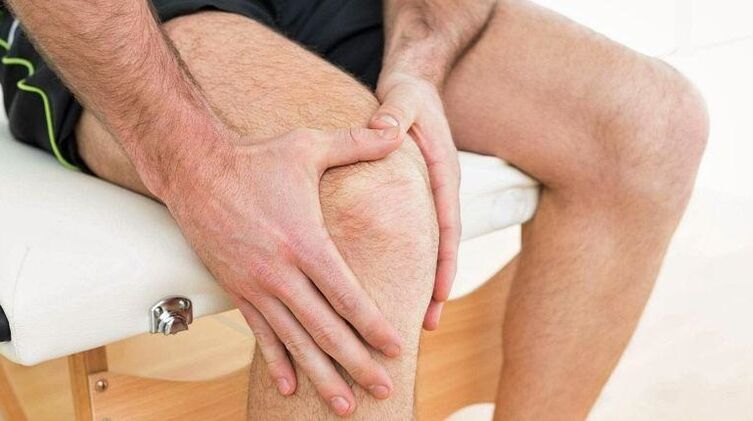
Every person experiences pain in the knee joint from time to time. It can be the result of a sudden movement or a symptom of a progressive pathology. The knee joint is the largest and most complex element of the musculoskeletal system. It accounts for up to 80% of physical weight, which leads to increased physical activity and risk of injury. A large number of capillaries, nerve fibers and muscle tissue make any injury, even minor, extremely painful. Injured nerves provoke an infectious-inflammatory process, which is accompanied by swelling, discoloration of the skin and an increase in local temperature.
As progress progresses, the joint itself, intra-articular fluid and connective tissues are drawn into the pathological state, which can have serious consequences - the development of arthritic diseases. A general understanding of the anatomical structure of the knee joint will help you understand what element can cause pain and what measures should be taken to eliminate pain.
Anatomical structure
The anterior zone of the joint is formed by the patella, in simpler language - the patella. It is connected to the quadriceps (fascicularis) muscle of the thigh, which continues into the patellar ligament and, in general, forms a ligamentous apparatus composed of the following types of fascia:
- Lateral branches of the tibia (small and large);
- back support knots - sickle-shaped, dorsal, middle and lateral;
- transverse and cruciate articular ligaments of the knee.
The cruciate ligaments are most susceptible to injury - a sudden movement, a large degree of rotation, a fall with subluxation leads to ruptures of the interminal joints.
Ligaments are divided into two types:
- Anterior - they have the function of stabilizing the ankle joint, in particular, preventing excessive forward displacement. They arise from the back of the large femur, cross with the posterior ligaments in the socket of the knee and attach to the notch between the anterior protrusions of the tibia.
- Back - to prevent the lower leg from rolling back. They start from the anterior upper part of the femur, pass through the articular cavity and end between the dorsal protrusions of the tibia.
On the surface of the articular bones is cartilage. At the junction of the tibia and the femur there are menisci - a kind of articular covering that plays a role of shock absorber and stabilization.
There are several synovial sacs (three to five) in the knee joint that provide natural lubrication:
- above the patella;
- deep popliteal;
- between the tendons of the longus of the thigh;
- hypodermic patella;
- in the recess under the knee joint.
Thanks to the knee, a person can take a step, bend, extend within the limits indicated by the ligaments.
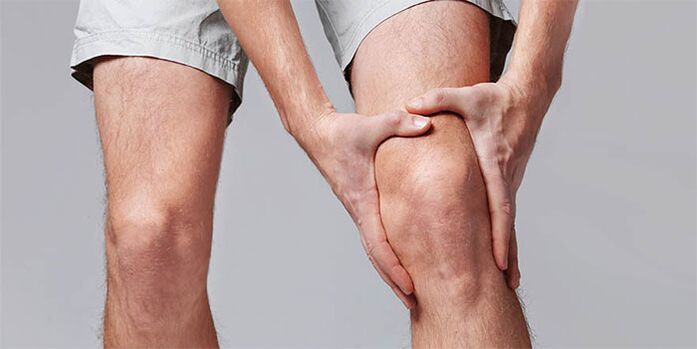
Causes of pain
Inflammation can develop in the following structures:
- cartilage;
- articular sheath;
- synovial fluid;
- tibia bone;
- muscles and tendons surrounding the joint;
- ligament apparatus;
- blood vessels, veins, arteries;
- subcutaneous fat;
- epidermis.
The most common causes of knee pain are:
- Osteoarthritis is the cause of more than 50% of cases of knee pain. It is characterized by a slow and progressive destruction of hyaline cartilage. For a long time it can be asymptomatic and sharply worsen in the second stage. Pain in the knee joint is due to the growth of osteophytes which affect the nerve endings.
- Arthritis is an inflammatory pathology that occurs in an acute form. It can be either an independent disease - spondylitis, or a complication of other joint pathologies - arthrosis, rheumatism, etc. Arthritis is characterized by severe pain, accompanied by swelling and redness;
- Osteochondritis - articular cartilage inflames over time with degenerative arthrosis, mechanical injuries;
- Periarthritis is a disease that occurs against the background of obesity (more often in women). The pathology affects the tendons, muscles, and then passes to the shell of the knee joint. The pain is moderate, pulling (as in a sprain).
- Chondromatosis is the formation of knots on the hyaline cartilage tissue, which eventually spreads throughout the capsule of the knee joint. In this case, a pinching of soft tissues with a large number of nerve cells occurs. Due to this, the knee constantly hurts, even during the period of rest.
- Bursitis - the synovial capsule of the knee joint rarely inflames, only as a result of injuries or complications of collateral joint diseases, hence the pain.
- Cellulite - subcutaneous fatty tissue can cause pain only in the case of close foci of concomitant diseases. Purulent arthritis, soft tissue abscess can cause inflammatory and painful processes in the protective layer.
- Dermatitis - the epidermis is affected in case of infectious pathologies (eczema, erysipelas, psoriasis) or allergic reactions to external stimuli.
- Osteomyelitis - the bone marrow becomes inflamed due to bacteria that have entered the jelly-like body with the lymph flow. It can also be the result of open wounds or a complication of surgical operations.
- Synovitis - the capsule of the knee joint is most often affected in people over the age of 55, as a result of rheumatism or other chronic pathologies. At a young age, you can get sick from a serious injury.
Types of pain according to location
Diseases that provoke the development of negative processes also form the type of pain:
- Severe, excruciating pain - reactive arthritis, torn menisci and tendons, acute stage bursitis;
- Tolerable, but constant pain - synovitis, bursitis in the initial degree;
- Pinching pain - gonarthrosis, arthrosis;
- Vibrant - degenerative arthrosis, in the stage of joint deformity;
- Acute burning pain - compression of the sciatic nerve, bone tuberculosis;
- Tingling - osteoporosis, progression of inflammation of the synovial sac, exacerbation of chronic damage to the meniscus;
- Cramps - inflammation of the soft tissues of the knee joint, muscles and tendons;
- Shooting pain - nerve root damage.
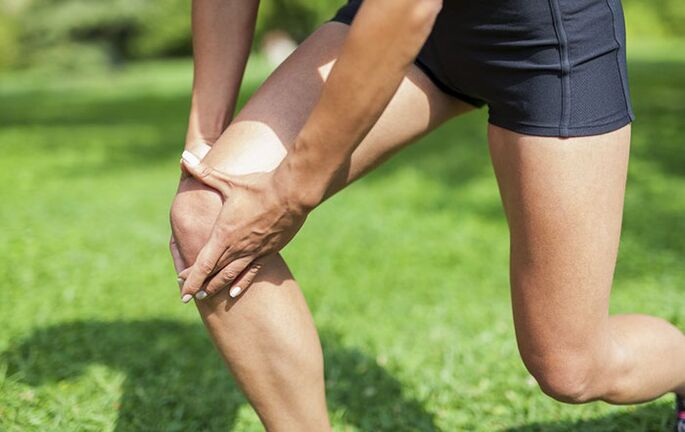
Diagnostic measures
If you have severe pain in the knee joints, you should not postpone a visit to the doctor, hoping that "everything will pass". Early diagnosis guarantees successful treatment and prevents the development of more serious processes that can cause irreparable harm to health and quality of life. For an initial consultation, you must contact a therapist. After a standard examination, he decides whether to prescribe treatment (which happens in 70% of cases of knee pain) or prescribes a comprehensive laboratory and material examination, with the participation of highly specialized specialists.
Running, suspicious pains are studied in different directions:
- Traumatology: if you suspect osteoarthritis, congenital or acquired dysplasia, joint fracture, dislocation, displacement, X-ray, MRI, ultrasound, fluid biopsy in the synovial sac is prescribed to find out where the pain is coming fromin the knee joint.
- Surgery: cyst under the patella, thrombosis, arthritis with purulent formations, ruptures of tendons, menisci, ligaments, stones inside the joint, hemarthrosis, abscesses are diagnosed by ultrasound, fluoroscopy, CT scan or MRI, blood tests, general and rheumatoid factor, hyaline puncture cartilage in the knee joint, etc.
- Rheumatology: the exclusion of systemic diseases (lupus erythematosus, rheumatoid arthritis, gout) is carried out using laboratory tests. Complete blood count, hematology, rheumatoid protein, DNA test, uric acid level.
- Neurology and psychiatry: pinched sciatic nerve does not require a long diagnosis. Already on ultrasound, muscle tone and sites of inflammation will be visible. In the case of mental disorders, when the pain in the knee joint is not confirmed by a single fact, but the patient continues to experience torments (the so-called somatic pain), specific studies are prescribed formental abnormalities.
Basic diagnostic methods
The most popular ways to quickly and accurately diagnose knee pain are:
- X-ray - allows you to see the knee joint in several projections and determine the location of the lesion. The images show damage already at an early stage, including changes in the bone, the synovial sac or the appearance of osteophytes.
- Ultrasound examination - a modern high-accuracy examination determines the thickness of the joint shell, the state of the ligament structure, the presence of inflammation of any type and general changes in the knee.
- Dopplerography - Examination of veins and arteries for aneurysms, plaques and blockages. Quickly and efficiently determines possible risks and the condition of the inner walls of blood vessels in terms of percentage.
- MRI is currently the most accurate means of diagnosis. Allows you to see a clear three-dimensional image of the knee joint, pathological changes in synovial fluid, even slight deformation of bone tissue, etc. It is rarely prescribed, due to the high cost, for many, and contraindications. It is forbidden to undergo an examination for patients with implants, metal prostheses and weighing more than 150 kg.
- CT - the principle of operation is based on X-rays, but in a more modern way. Images are taken in a circular projection, which allows you to get a more accurate picture of the knee joint and thereby determine the nature and extent of the injury.
- Angiography is a method of examining blood vessels for patency by injecting contrast fluid. Determines the functionality of metabolic processes and helps to diagnose joint failure in the early stages.
- Complete blood count - is prescribed to identify inflammation and pain. The set of indicators can even lead to the trail of specific diseases and only determine joint pathologies at the very beginning of evolution.
- Blood for rheumatoid antibodies - also indicates the presence of inflammation, but of a specific, systemic or hereditary nature. For example, to establish a diagnosis of rheumatoid arthritis, this analysis is taken as the basis.
- Uric acid is an important test to determine the causes of pain and the stage of exacerbation of gout or infectious arthritis. A high level indicates the accumulation of salt deposits in the joints.
- Wasserman's reaction - is prescribed for suspected sexual infections, syphilis, gonorrhea, chlamydia, etc. The development of joint diseases against the background of specific diseases or their complications is very common. Therefore, a positive test will allow to prescribe the correct treatment taking into account the type of infection.
- Tumor markers - help identify special substances in the blood that are secreted by a cancerous neoplasm or its metastases. Thus, for sarcoma of the synovial sac, the presence of markers of vimentin, cellular external antigen and pancytokeratin is characteristic.
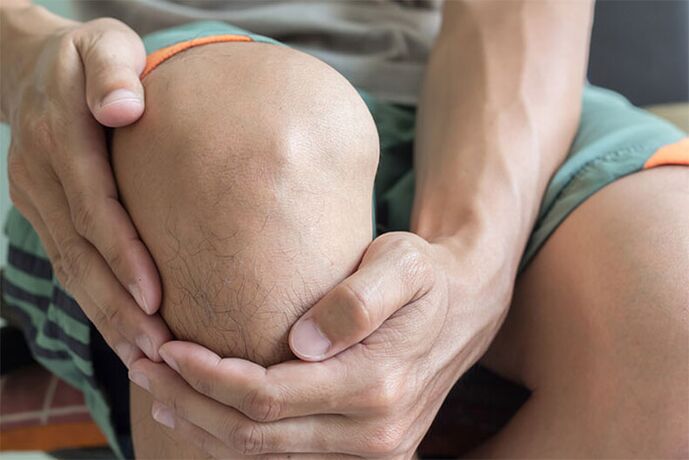
Treatment of pain in the knee joints
Knee pain can be divided into those that require emergency medical attention. And those who are pre-diagnosed. Urgent conditions include all injuries, fractures, dislocations, abscesses, purulent inflammation, hemarthrosis (bleeding into the joint). The symptoms in all cases are the same - unbearable pain, swelling, redness, inability to move, fever in the knee joint and a feverish state.
Treatment is limited to providing primary care until the ambulance arrives:
- the leg should be lifted - put a rolled roller or a hard pillow;
- put a bandage with ice on the knee and change it every 5-10 minutes;
- take an available painkiller.
In all other cases, treatment is carried out after conducting in-depth studies and establishing the causes. Depending on the anamnesis, drug therapy, physiotherapy, exercise therapy, massage, homeopathic treatment, local applications, spa vacations and, in extreme cases, surgery are prescribed.
Conservative therapy
Traditional drug therapy for pain includes the following drug groups:
- Anesthetics. To relieve early symptoms and reduce pain, you can take simple over-the-counter pain relievers. Severe cases associated with loss of mobility and unbearable pain require more serious medications that are only prescribed by a doctor and are available by prescription.
- NSAIDs. Helps quickly relieve inflammation and swelling.
- Chondroprotectors. Modern drugs, despite the long duration of administration, provide regeneration of cartilage tissue. The effect is cumulative and long-lasting (up to 10 years, joint pain may not bother after a course of six months, subject to treatment in the early stages).
- Glucocorticosteroids. Indicated for patients with autoimmune pathologies to reduce the production of the hormone cortisol and stop the progression of the disease. Doses and diet are prescribed by the doctor on a strictly individual basis.
- Immunosuppressants. They suppress the abnormal action of the defense system, thus stabilizing the progression of dangerous diseases such as rheumatoid arthritis, lupus erythematosus and vasculitis. They are rarely prescribed, only in the case of an accurate diagnosis and the inability to eliminate knee pain by other means.
- Injections of hyaluronic acid. They are injected directly into the cavity of the knee joint and eliminate pain and synovial fluid deficiency. They also contribute to the restoration of hyaline cartilage, thus restoring the mobility of the knee.

Folk recipes
Most people who start having pain in the knee joint try to eliminate the discomfort with traditional methods. You can make lotions, compresses, and nighttime applications using homemade ointments or tinctures. A decoction of herbs, alcohol tinctures for topical use will help prevent a period of exacerbation and relieve obsessive pain.
The following plants and substances have anti-inflammatory effects:
- Coltsfoot;
- St. John's wort;
- oak bark;
- Burdock root;
- Bay leaf;
- chamomile flowers;
- marigold;
- White and black kaolin clay;
- A solution of salt and soda;
- Honey products.
For example, mix 10 aspirin tablets, previously crushed, and a glass of liquid honey. Apply a thick layer on the knee in the area where the pain is located. Cover with cling film and wrap with a woolen cloth (scarf), preferably left overnight. The pain is eliminated after the first application.
In the same way, you can apply a clay application where the pain appears. A little olive oil is added to the clay and water mixture to prevent hardening and severe tightening of the skin.
An effective recipe, which includes honey, salt and soda. Mix 1 teaspoon of salt and soda with honey, enough to thoroughly cover the knee joint. This method performs three actions at once - removes excess fluid, relieves inflammation and pain, enriches with nutrients.
Oak bark in the form of an alcohol decoction or tincture well strengthens blood vessels, promotes normal blood circulation. For a decoction, pour 1 tablespoon of dried bark with 1 cup of boiled water, cook in a water bath for 20 minutes. Soak the gauze with the decoction and apply to the knee in a warm (not hot) form for 30-50 minutes to eliminate pain in the knee joint. For alcohol tincture, use the same proportions, replace water only with vodka. Insist in a dark cool place for 10-14 days. Apply in the same way.
By alternating various means and methods, you can save the disease for a long time, forget about pain and swelling. The effectiveness of alternative medicine has not been proven, despite the elimination of the main symptoms - pain in the knees.
Massage and therapeutic exercises for pain in the knee joints
A comprehensive traditional treatment necessarily includes exercise therapy and massage. Exercises are recommended for all people who have had or have knee injuries, diagnosed with arthritis, osteoarthritis and other joint diseases, leading an inactive life (static sedentary work, disability of 1-2groups, housewives, etc. ).
Gymnastics can be done independently, at a slow pace and in a feasible mode. Gradually increase the number of exercises or, on the contrary, reduce it, depending on your state of mind.
- Lying down or sitting on a chair, bend and straighten your legs slowly, until a state of slight fatigue appears.
- Bend the leg at the knee, perform rotational movements in a small amplitude, repeat the same on the second leg.
- Lying on your back, gently pull the legs bent at the knees towards the stomach.
- Put a pillow on the chair and sit down so that the legs "hang", perform clockwise circular movements and vice versa.
- Sitting on a chair, slowly stretch your leg and hold this position for 2-5 seconds, lower it just as slowly, repeat on the second leg.
- Stand straight, straighten your back, slowly bend your leg at the knee and linger in the "heron" position for several seconds. If possible, every 2 days, increase the time.
- If there are no contraindications and health permits, you can complicate the complex. Put the gymnastic stick at the maximum level, which can be reached with a bent leg at the knee. Throw the leg over the "barrier" 10-15 times, then change position.
- A small complex for stretching the lower leg also contributes to the rapid recovery of the knee joint. Press your palms on the wall, bend your right leg at the knee, place your left leg back. The feet rest completely on the ground. Hold the pose for 30 seconds. Switch legs.
Regular performance of simple gymnastics, available to any person, will give noticeable results in a month - pain in the knee joint will cease to bother, joint mobility will improve, swelling will disappear.
The effectiveness of gymnastics will increase significantly if you combine it with a massage course. It can be both a traditional exposure method and manual pain therapy. It is only worth remembering that only experienced professionals with good recommendations should be trusted to perform such procedures. Otherwise, manual manipulations, at best, will not have the slightest effect, at worst, they will cause joint displacement and aggravate the pathological condition. Massage should be done periodically, no more than 10 sessions, 25-30 minutes per month. Daily procedures are strictly contraindicated. During the session, there should be no pain in the knee area. If discomfort is felt, the procedure should be stopped.
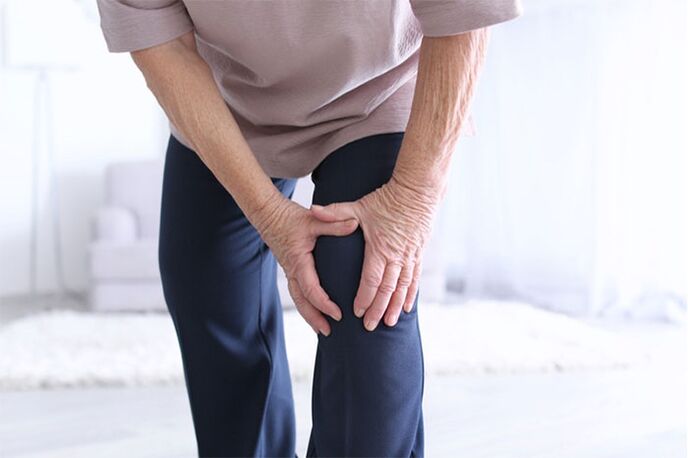
Home treatment
Treating knee pain at home is a prerequisite for outpatient therapy. The patient, by all permissible methods, should help themselves to relieve pain and recover as quickly as possible.
Therefore, for these purposes, it is necessary to adhere to certain rules for the treatment of all types of pain:
- Follow all the recommendations of the attending physician - do not miss taking prescribed medications, do feasible gymnastics, come on time for physiotherapy.
- Review your diet. Add plenty of fresh vegetables, herbs, and fruits to your diet. Exclude fatty meat, fried foods and semi-finished products.
- If necessary, use aids to relieve the load on the knee joint - cane, crutch and other special devices.
- Do not use, without prior consultation with a doctor, recipes of traditional medicine, even time-tested and neighbors. What helps one person may be categorically contraindicated for another.
- During the treatment period, if possible, avoid physical activity and ensure bed rest so that the pain does not return (therapeutic exercises are an exception).
- Provide a comfortable place to sleep and rest - orthopedic mattresses, comfortable chairs and armchairs, preferably with small supports so you can comfortably lift your aching legs.
- Light self-massage is permitted. Caresses and rubbing promote blood circulation, thus enriching the tissues with oxygen. Thus, muscle spasms are suppressed and the pain becomes less intense.
Preventive measures
It is almost impossible to fully insure against injuries, sprains or dislocations of the most heavily loaded joint in the body. Daily life requires you to do your household chores, go to work, etc. In the course of normal activities, it is quite possible to sustain an unexpected injury. But reducing the risk of developing joint disease is entirely within everyone's power. Leading rheumatologists have developed a number of recommendations that will help protect you from dangerous pathologies:
- Establish and strictly adhere to a rational regime - work-rest. This is especially true for people whose activities are associated with increased physical activity (athletes, builders, salespeople, metalworkers, miners, etc. ).
- Treat and rehabilitate in a timely manner after any infectious disease. This rule even applies to "harmless" infections such as acute respiratory infections or seasonal SARS.
- Avoid exposure to low temperatures, drafts. Dress for the weather to avoid hypothermia.
- At the age of 35, it is desirable to undergo treatment with chondroprotectors.
- Watch your weight carefully. Increasing body weight will inevitably increase the load on the knees, this should be remembered when eating another bun.
- In order to maintain a normal weight, adhere to the principles of healthy eating. More vegetables and dairy products - less sweet, spicy, salty, fatty and starchy foods.
- Reconsider your lifestyle - quitting smoking, drinking alcohol and other toxic addictions will have a positive impact not only on knee joints, but also on life in general. To overcome addictions, you can ask for help from loved ones - the difficult stage will pass much faster and easier.
Every person has experienced pain in the knee joints, regardless of age, gender or social status. From the first steps, the joint is subjected to all sorts of tests - falls, bruises, injuries, sports, hypothermia. Despite this, many people manage to maintain the mobility, health and functionality of the main compound well into old age.























